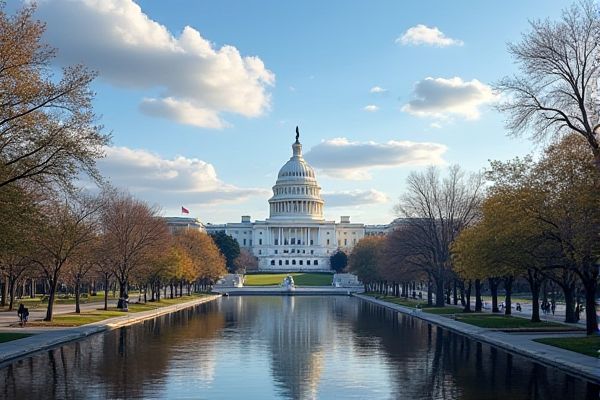
Transportation and commuting in Washington: Extensive Metro system. Metro SmarTrip card. Dulles International Airport. Reagan National Airport. MARC and VRE commuter trains. DC Circulator bus. Traffic congestion. Bikeshare program. Carpooling lanes. Walking-friendly neighborhoods.
Extensive Metro system
The Washington, DC Metrorail system offers safe, clean, and reliable transit services, catering to over 600,000 customers daily across 98 stations spread across Virginia, Maryland, and the District of Columbia. With six color-coded rail lines, namely Red, Orange, Silver, Blue, Yellow, and Green, the Metrorail efficiently connects various regions and enhances mobility. For more information, visit the official Washington Metropolitan Area Transit Authority website.
Metro SmarTrip card
The SmarTrip Card is a versatile payment method for public transportation in the Washington, D.C. area, usable on Metrorail, Metrobus, regional buses, and Metro parking facilities. It offers features like contactless mobile payments, auto reload, and balance protection. For more detailed information on its functionalities and benefits, you can visit the official SmarTrip Card page.
Dulles International Airport
Washington Dulles International Airport is connected to the Metrorail system via the Silver Line, accessible through an underground pedestrian tunnel from the main terminal. Additional transportation options include airport shuttles, private car services, and general airport parking, but no Metro commuter parking or bike facilities are available. For more details, you can visit the Silver Line Extension page.
Reagan National Airport
Ronald Reagan Washington National Airport (DCA) offers various transportation options, including public parking for over 8,500 vehicles, seven on-airport car rental companies, more than 3,000 taxicabs dispatched daily, and courtesy shuttle buses to and from the terminals and economy parking lots. Additionally, the airport is served by Metrorail and several private car and shuttle services, such as those provided by GO, offering economy and premium private car services. For more information about the facilities and services, visit the Ronald Reagan Washington National Airport overview on their website.
MARC and VRE commuter trains
The Washington, DC area is served by two commuter rail services: MARC (Maryland Area Regional Commuter) and VRE (Virginia Railway Express). MARC operates between Union Station in DC and Maryland with three lines: Penn, Camden, and Brunswick, while VRE connects Union Station to Virginia along the Manassas and Fredericksburg lines. Both services operate Monday through Friday, with MARC's Penn Line also offering weekend service. A new agreement allows passengers to transfer between MARC and VRE using the same pass at no additional cost.
DC Circulator bus
The DC Circulator is a public transportation system in Washington, D.C., offering six distinct bus routes that connect major attractions, neighborhoods, and transit hubs. It provides frequent service every 10 minutes, comfortable buses, and an affordable fare of $1, serving over 5 million trips annually. For more information, you can visit the DC Circulator website to plan your journey and explore everything Washington, D.C. has to offer through this efficient transit option.
Traffic congestion
Traffic congestion in Washington is on the rise, with 34.2 billion miles logged on state highways in 2022, marking a 1.2% increase from the previous year. This surge has resulted in significant delays and economic repercussions, especially in the Central Puget Sound region where delays have soared by 35%. As these issues persist, local lawmakers are actively seeking solutions to address the growing problem and mitigate its impact on commuters and the economy.
Bikeshare program
Capital Bikeshare is Metro DC's bikeshare system, featuring over 700 stations and 6,000 bikes across the metro area. Users can unlock bikes using the Capital Bikeshare or Lyft app, ride, and then park the bikes at designated docking stations, with various membership and pass options available, including single rides, day passes, and annual memberships.
Carpooling lanes
In Washington, High Occupancy Vehicle (HOV) lanes are reserved for carpools, vanpools, buses, and motorcycles, with specific occupancy requirements and the option for non-HOV drivers to use express toll lanes and High Occupancy Toll (HOT) lanes by paying a toll. These lanes are designed to maximize the movement of people, reduce traffic congestion, and encourage commuters to use transit or carpool. To learn more about how these lanes facilitate efficient travel, you can visit the WSDOT website. The application of HOV lanes reflects a commitment to improving the overall transportation infrastructure and promoting sustainable commuting habits across the state.
Walking-friendly neighborhoods
Washington's most walkable cities, led by Seattle with a Walk Score of 74, feature pedestrian-friendly neighborhoods like Capitol Hill and Belltown. Other notable cities including Tacoma, Lynnwood, and Kirkland, offer easy access to amenities, public transport, and bike lanes. This promotes healthier and more eco-friendly living. For more insights, refer to the list of Most Walkable Cities In Washington to explore how these cities combine convenience and sustainability.
